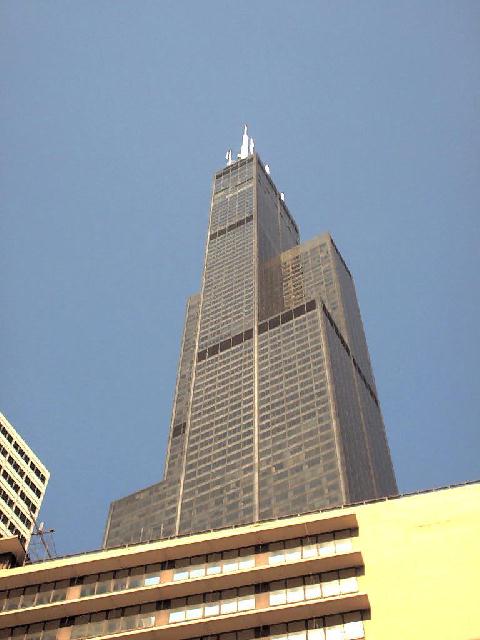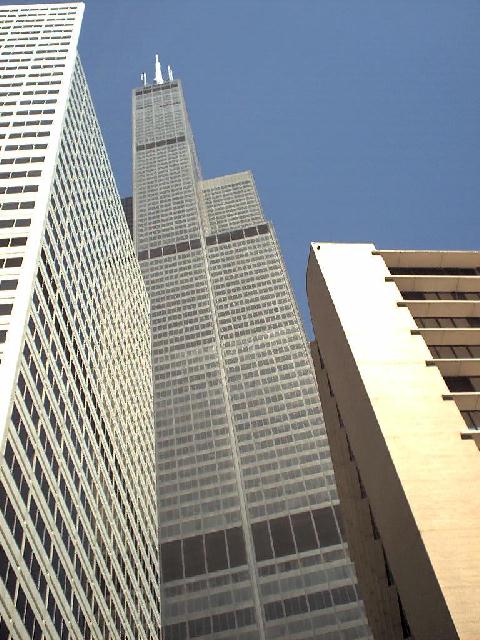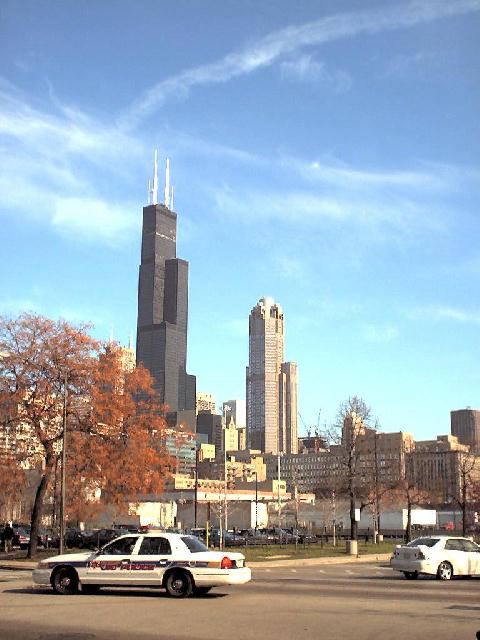|

 - -
 
2001 NB
|
|
The
day lasts three minutes longer
at the top of the Sears Tower, which is the first place to see the sun
rise over the city and the last to see it set. The Sears soars a quarter
mile into the air (or five football fields, to use the conventional base
unit of gigantic measurement), sleek and stylish as a black leather jacket,
topped with ivory tusks that punch the clouds. The building is actually
a bundle of nine tubes with staggered roofs; the tallest two rise 110 stories.
Its foundation and floor have enough cubic feet of concrete to build an
eight-lane highway five miles long; the building weighs more than a quarter
of a million tons and is blanketed by more than 16,000 windows. Its population
of workers is equivalent to Illinois' 30th largest town.
Much to Chicagoans' chagrin, the
Petronas Towers in Malaysia snatched the title of world's tallest building
back in 1996 after Sears' 22-year reign. But that was only after the Petronas
twins thrust their spires 30 feet beyond the Sears' roof. Sears' owners
were so stung that they appealed to something called the Council on Tall
Buildings and Urban Habitat at Lehigh University. In 1997, the Council
issued a decree that tall buildings would henceforth be measured in four
ways: tallest top, highest floor, tallest roof, and tallest antenna. The
Petronas Towers and their spires claimed the title in the first category,
Sears had the next two and then gobbled up the fourth when it extended
one of its attennas one foot higher than the attenna on the north tower
of New York City's World Trade Center. (Toronto's CN Tower is taller than
all of the above, but is considered a freestanding structure, not a building
[see this]. And
did you know that while these skyscrapers are the pride of their mega-metropolises,
a
2000-foot television tower in the middle of North Dakota has them all
beat?) In short, the Sears is the highest place in the world you can stand,
and what more could you ask for in a skyscraper? (See a good breakdown
of the race to be tallest
from
the Chicago Reader.)
Sears was spawned in an era of clunky
gigantism--a phase America was going through in the early 1970's--and has
maintained an aloofness ever since, as Chicago Tribune architecture
critic Blair Kamin points out (see below). Big-boned and impersonal, it
is admired but not loved by Chicagoans and tourists. Sears is like the
overachieving oldest child parents boast of at parties but silently wish
they were closer to; the Hancock Tower is slightly less audacious and more
embraceable. Kamin writes that Sears executives blame the building--with
its seemingly interminable expanses of offices and separate elevator systems--for
creating a stagnant corporate culture that contributed to Sears' surrender
to Wal-Mart as the country's leading retailer. Sears has since moved out
of its namesake tower and fled for the suburbs.
I retain a greater fondness for the
Sears Tower's architecture than does Kamin, whom I greatly respect as a
writer and a person. As Kamin concedes, "From certain vantage points, the
tower posesses a stepped-back silhouette that dominates the skyline rather
than simply marking it like an overgrown tombstone." The Sears Tower does
indeed command the cityscape and grabs glances from all angles; its arresting
architecture ably climaxes a complex skyline. I visited New York City for
the first time in the summer of 2001, and the World Trade Center just didn't
seize the eyes and imagination; the Empire State Building kept yanking
you back. Sears may not embrace its own street corner or embody the city's
personality the way the
Hancock Tower does, as Kamin writes, but I like its various "big shoulders"
and its stark, unembellished profile in a city known for both its stocky
build and Midwestern understatement. The Sears is not just an imposing
presence, but a defining icon. -NB
Blair Kamin:
Since its completion in 1974, Sears
has failed to capture the popular imagination the same way as the 102-story
Empire State, whose robust setbacks and powerfully sculpted mooring mast
were made to order for the celluloid climbing exploits of King Kong. Nor
has Sears become a beloved urban icon in the manner of the 100-story John
Hancock Center, whose bold X-braces and tapering profile lend it a skyline
swagger that perfectly captures Chicago's broad-shouldered image of itself.
Sears, in short, is more a triumph of engineering than of architecture,
a building that is admired more for achieving great heights than for its
ability to translate its structural bravura into sky-high drama.
-from Why
Architecture Matters: Lessons From Chicago
 From
SearsTower.com,
the building's official site: From
SearsTower.com,
the building's official site:
Sears Tower is a triumph of ingenuity
and innovation reflecting Chicago's and America's strength, vision, and
tradition of architectural excellence.
-More
from the official site, including one
of my favorite pictures of the building.
Sears Tower
architect Bruce Graham, quoted at About.com
The stepback geometry of the 110-story
tower was developed in response to the interior space requirements of Sears,
Roebuck and Company. The configuration incorporates the unusually large
office floors necessary to Sears' operation along with a variety of smaller
floors. The building plan consists of nine 75 x 75 foot column-free squares
at the base. Floor sizes are then reduced by eliminating 75 x 75 foot increments
at varying levels as the tower rises. A system of double-deck express elevators
provides effective vertical transportation, carrying passengers to either
of two skylobbies where transfer to single local elevators serving individual
floors occurs.
Further Reading:
-Sears
Tower at Skyscrapers.com
-Sears
Tower at Skyscraper.org
-Sears
Tower facts from About.com
-About
the world's tallest buildings from HowStuffWorks.com
See also:
Form
Follows Finance: Skyscrapers and Skylines in New York and Chicago by
Carol Willis. |
|
|